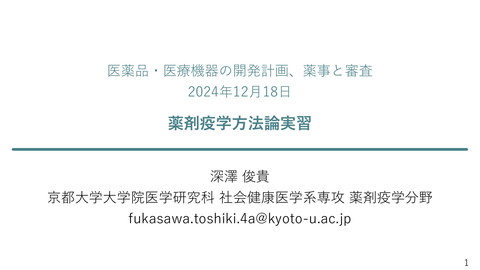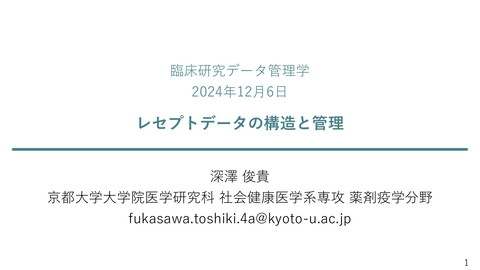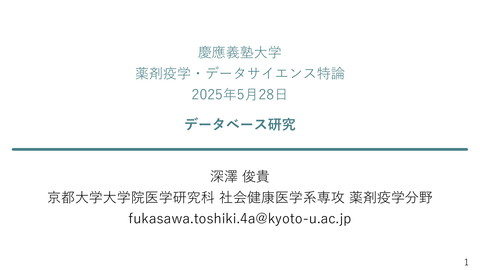Real-World Evidence from Japan: Healthcare Infrastructure, Data Resources, and Emerging Pharmacoepidemiologic Insights
487 Views
September 04, 25
スライド概要
Seminar on Pharmacoepidemiology and Public Health at the University of Oslo
September 9, 2025, Oslo, Norway
https://www.mn.uio.no/farmasi/english/research/news-and-events/events/guest-lectures-seminars/2025/seminar-on-pharmacoepidemiology-and-public-health.html
京都大学大学院医学研究科社会健康医学系専攻薬剤疫学分野 講師
関連スライド
各ページのテキスト
Real-World Evidence from Japan: Healthcare Infrastructure, Data Resources, and Emerging Pharmacoepidemiologic Insights September 9, 2025 Toshiki Fukasawa, PhD Associate Professor Department of Pharmacoepidemiology 1
Overview 1 My Career Journey as a Pharmacoepidemiologist 2 Japan’s Health Insurance System 3 Electronic Health Databases and a Study Example 2
Educational Background and Professional Experience Education • BSc in Pharmaceutical Sciences, Keio University, Japan, 2017 • MSc in Pharmaceutical Sciences, Keio University, Japan, 2019 • PhD in Medical Science, Kyoto University, Japan, 2024 Experience • Research Associate, Tohoku University, Japan, 2019–2020 • Assistant Professor, Kyoto University, Japan, 2020–2024 • Associate Professor, Kyoto University, Japan, 2024–Present • Consultant (Contract): AstraZeneca, MSD, Eisai, Asahi Kasei Pharma, and Kyowa Kirin 3
Experience at Kyoto University School of Public Health • As of 2025, we have 6 faculty members and 38 graduate students in our lab. • I have supervised 10 graduate students. 4
Japan’s Health Insurance System Established in 1961 with 3 Key Features 1. Universal Health Care: Guarantees coverage for all citizens. 2. Free Access to Healthcare Providers: Guarantees access to any health provider without referrals. 3. Affordable Care through Variable Copayments: Adjusts copayments based on age and financial status, ensuring healthcare is accessible to all. 5
Universal Health Care Health Insurance System Insured Persons (N) (1) Employee’s health insurance Employees and their family members (77.4 million) (2) National health insurance Unemployed, self-employed, or retired individuals and their family members (28.1 million) (3) Late-stage medical care system for the elderly People aged 75 and older (18.4 million) Age 0–74 years ≥75 years 6
Insurance Treatments and Real-World Data Generation Insured Person Insurer Medical Institutions Claim Hospital-Based Databases Claim Examination and Payment Organization Administrative Claims Databases 7
(1) Administrative Claims Databases in Japan Database Primary care Specialist Inpatient care care • National Database (NDB): Covers almost all Japanese citizens. • JMDC Claims Database*: Covers employees and their family members under 75 years old. • DeSC Database*: Includes diverse populations across various ages and social backgrounds. *Commercially available. Information • Demographics • Inpatient and outpatient diagnoses • Procedures • Drug dispensing • Health checkups: Primarily for ages 40–74 years8
(2) Hospital-Based Databases in Japan Database Primary care MID-NET, RWD Database*, JMDC Hospital Database*, MDV Database*: Cover both inpatient and outpatient services in treated hospitals. *Commercially available. Information • Demographics Specialist Inpatient care care • Inpatient and outpatient diagnoses • Procedures • Drug dispensing • Discharge summaries • Laboratory values: Fully available from MID-NET and RWD Database; partially available from JMDC Hospital Database and MDV Database 9
Study Example Using an Administrative Claims Database • Observational study of denosumab vs. oral bisphosphonates for cardiovascular safety and fracture prevention in maintenance dialysis patients with osteoporosis. • Data source: claims data from DeSC Healthcare Inc. • Methods Editor: Prof. Miguel Hernán Masuda S, et al. Ann Intern Med. 2025;178(2):167-176. 10
Background of the Research Concept • Bisphosphonates (BPs) are first-line for osteoporosis but are renally cleared, limiting use in CKD. Dialysis patients lack kidney function, so this restriction may not apply. • Denosumab can be used regardless of renal function; close Ca monitoring is essential and cardiovascular safety data are still limited. • No RCTs target dialysis patients; a systematic review of CKD stages 3–5 gave no firm recommendations. • A recent study in dialysis patients: 12-week severe hypocalcemia incidence = 41.1% with denosumab vs. 2.0% with oral BPs. Bird ST, et al. JAMA. 2024;331(6):491-499. 11
Target Trial Emulation Step 1: Specifying the protocol of the hypothetical pragmatic RCT that would answer the causal question of interest (the target trial) 1. Eligibility criteria 2. Treatment strategies 3. Treatment assignment 4. Outcomes 5. Start and end of follow-up Causal estimands 6. Causal contrasts 7. Data analysis Step 2: Using the observational data to emulate that trial 12
Eligibility Criteria Target trial specification Target trial emulation Inclusion criteria: (1) Age ≥50 years + osteoporosis (2) On maintenance dialysis Inclusion criteria: Same as for the target trial Exclusion criteria: Exclusion criteria: (1) History of Paget’s disease of bone, (1)–(4) Same as for the target trial malignant tumor, or giant cell tumor (5) ≥1 year of continuous enrollment in the (2) Prior renal transplant database before treatment assignment (3) Prior use of denosumab or BPs (4) Admission for acute myocardial infarction, stroke, or heart failure within 90 days before treatment assignment 13
Treatment Strategies Target trial specification Target trial emulation (1) Initiation of denosumab (2) Initiation of an oral BP Same as for the target trial Decisions about treatment duration were left to the clinician’s discretion. • Only time-fixed treatments were emulated. • Time-varying treatments could not be emulated because sufficient data on adherence-related time-varying confounders were not available. 14
Treatment Assignment Target trial specification Target trial emulation Patients are randomly assigned to either strategy at baseline and informed of their treatment strategy. Patients were classified to the treatment strategy compatible with their observed data and randomization is assumed within levels of the baseline variables. • To adjust for baseline imbalances due to confounders, we applied inverse probability weighting (IPW). • As baseline covariates for confounding adjustment, we selected variables satisfying the modified disjunctive cause criterion, based on subject-matter knowledge: demographics, comorbidities, prior medication use, and healthcare utilization. 15
Outcomes Target trial specification Target trial emulation Safety outcome: Safety outcome: MACE (acute myocardial infarction, stroke, Same as for the target trial hospitalization for heart failure, cardiovascular death) Efficacy outcome: Composite fracture (vertebral, hip, pelvis, femur, leg, ankle, shoulder, arm, forearm, and wrist fracture) Effectiveness outcome: Same as for the target trial • Both safety and effectiveness outcomes were defined using a combination of diagnoses and drugs/procedures, with positive predictive values expected to exceed 90% according to validation studies. 16
Start and End of Follow-up Target trial specification Target trial emulation Total effect: Total effect: Follow-up starts at treatment assignment Same as for the target trial and continues until development of the outcome of interest, loss to follow-up, 3 years after treatment assignment, or administrative end of study (October 2022), whichever occurred first. • Our target estimand was the total effect (a well-defined causal effect) rather than the controlled direct effect (an ill-defined causal effect). • Patients were not censored at the competing event of death and were followed outcome-free until the end of follow-up, which is appropriate for estimating the total effect. 17
Causal Contrasts Target trial specification Target trial emulation Intention-to-treat effect Observational analogue of the intentionto-treat effect • In observational studies, the effect of initiating treatment strategies is defined as the observational analogue of the intention-to-treat effect. • This preserves the key feature of intention-to-treat effect in RCTs: independence from post-baseline adherence. • We did not estimate the observational analogue of the per-protocol effect because sufficient data on adherence-related time-varying confounders were not available. • However, only 16.1% of denosumab initiators and 13.9% of oral BP initiators switched to other osteoporosis drugs, so major differences between intention-totreat and per-protocol effects were not expected. 18
Data Analysis Target trial specification Target trial emulation Intention-to-treat analysis: Three-year risk differences and risk ratios were calculated from cumulative incidence curves. Intention-to-treat analysis: Same as for the target trial • Hazard ratios (HRs) are generally not causally interpretable. ○ Cox models assume constant hazard ratios over time (the proportional hazards assumption), but this assumption is often violated in practice. ○ HRs have built-in selection bias: if treatment affects outcomes, susceptible individuals are removed early, causing bias (depletion of susceptibles). • To overcome these issues, comparisons based on risk (cumulative incidence) are recommended, which allow a causal interpretation. 19
Results Denosumab may increase cardiovascular risk but reduce fracture risk compared with oral BPs. • MACE: 3-year RD, 8.2% (95% CI, –0.2% to 16.7%); 3-year RR, 1.36 (95% CI, 0.99 to 1.87) • Fracture: 3-year RD, –5.3% (95% CI, –11.3% to –0.6%); 3-year RR, 0.55 (95% CI, 0.28 to 0.93) 20
Social Impact 21
Future Perspectives 1. Continue training and mentoring graduate students to help cultivate the next generation of pharmacoepidemiologists. 2. Further promote the field of pharmacoepidemiology in Japan. 3. Expand international research collaborations globally to improve public health outcomes (e.g., my ongoing collaboration with Dr. Nhung Trinh). 22





